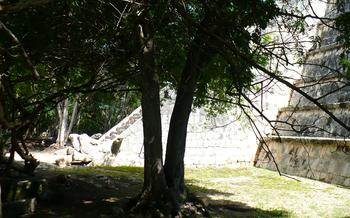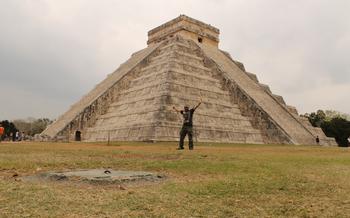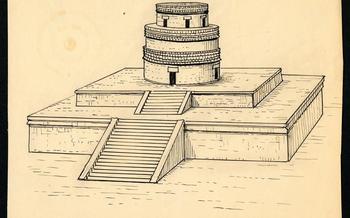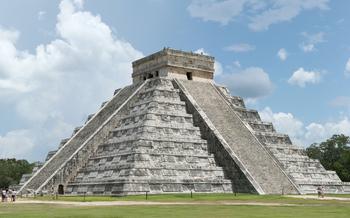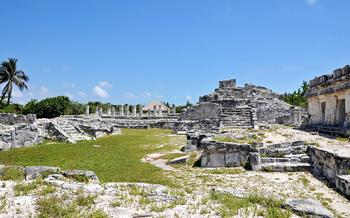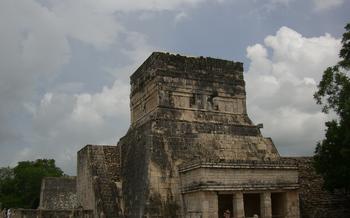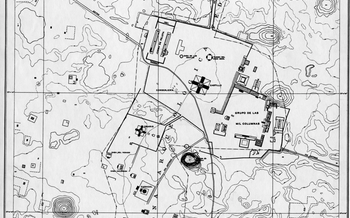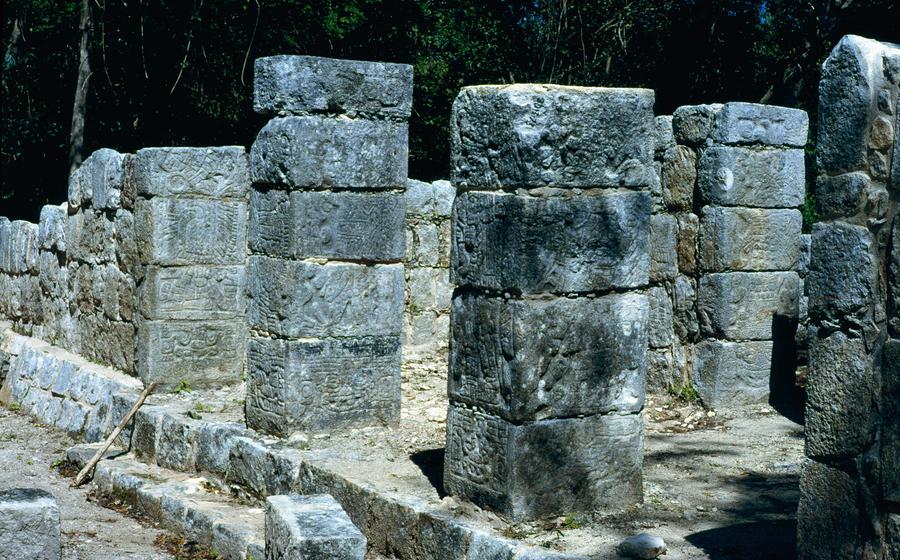
Temple of Xtoloc
- Chichen Itza, a Mayan City of Wonders
- The Temple of Kukulcan (El Castillo)
- Exploring the Temple's Interior
- The Great Ball Court
- The Sacred Cenote
- The Temple of the Warriors
- Las Monjas Complex
- The Caracol Observatory
- The Temple of the Skulls
- The Cenote Xtoloc
- History of the Maya Civilization
- Tips for Visiting Chichen Itza
- Cultural Significance and Preservation
- Sustainable Tourism Initiatives:
- Anecdotes and Personal Experiences
- Insider Tip: Capturing the Magic and Mystery
Chichen Itza, a Mayan City of Wonders
In the heart of Mexico's Yucatán Peninsula lies Chichen Itza, a majestic Mayan city that once flourished as a vibrant center of power, culture, and spirituality. With its impressive architecture, profound symbolism, and enduring legacy, Chichen Itza stands as a testament to the ingenuity and sophistication of the ancient Maya civilization. As you step into this awe-inspiring metropolis, prepare to be captivated by its iconic landmarks, explore its intricate alleyways, and immerse yourself in the mysteries of this once-great city.
Situated approximately 120 kilometers east of Mérida, Chichen Itza is easily accessible by car or guided tour. The city's strategic location, at the crossroads of major trade routes, allowed the Maya to establish a vast network of connections, facilitating the exchange of goods, ideas, and cultural influences throughout the region.
Chichen Itza's profound significance in Mayan civilization is reflected in its monumental architecture, intricate carvings, and complex systems of astronomy, mathematics, and writing. The city's rich cultural heritage is evident in its vibrant art, elaborate rituals, and deep spiritual beliefs. As you wander through the ruins, you'll encounter remnants of a civilization that left an indelible mark on the history and culture of Mesoamerica.
The Temple of Kukulcan (El Castillo)
In the heart of Chichen Itza stands El Castillo, an architectural masterpiece and the most iconic symbol of the Mayan civilization. This majestic temple, also known as the Temple of Kukulcan, rises proudly in the form of a stepped pyramid, showcasing the incredible engineering and astronomical prowess of the ancient Maya.
Ascending the 365 steps, one for each day of the year, leads visitors to the temple's summit, offering breathtaking views of the surrounding ancient city. The temple's design embodies the Mayan fascination with celestial events. Its four sides align with the cardinal directions, and during the spring and autumn equinoxes, a spectacular phenomenon occurs. As the sun sets, the interplay of light and shadow creates the illusion of a serpent descending the pyramid's northern staircase, representing the return of the feathered serpent god, Kukulcan.
The Temple of Kukulcan is adorned with intricate carvings, each holding symbolic and mythological significance. Feathered serpents, jaguars, and rain gods embellish the temple's facade, paying homage to the Maya's spiritual beliefs and their connection to the natural world.
Exploring the Temple's Interior
The Temple of Kukulcan, also known as El Castillo, offers a unique opportunity for visitors to delve into the mysteries of its inner chambers. Access to the temple's interior is limited to ensure the preservation of its delicate structures, but those who are fortunate enough to enter are rewarded with a glimpse into the sacred world of the Maya.
The interior of the temple consists of a series of chambers and passageways, each with its own significance. The most notable chamber is the inner sanctum, which houses the Red Jaguar Throne. This elaborately carved throne is believed to have been used by the Maya priests for religious ceremonies and rituals. The walls of the inner sanctum are adorned with intricate bas-reliefs depicting scenes from Maya mythology and history.
Other chambers within the temple contain various artifacts and inscriptions, providing valuable insights into the beliefs and practices of the Maya. Visitors can admire the well-preserved murals and sculptures, which depict Maya deities, rulers, and scenes from everyday life. The temple's interior also reveals evidence of the Maya's advanced knowledge of astronomy and mathematics, with alignments that correspond to celestial events.
Among the most intriguing discoveries within the temple is the Red Jaguar Throne. This throne is carved from a single block of limestone and features a jaguar head with inlaid jade eyes. The jaguar was a powerful symbol in Maya culture, representing strength, power, and rulership. The throne is believed to have been used by the Maya ruler, or halach uinic, during important ceremonies and rituals.
The exploration of the Temple of Kukulcan's interior is a journey through time, offering a glimpse into the spiritual beliefs and cultural practices of the ancient Maya civilization. It is an experience that leaves visitors with a deeper appreciation for the ingenuity and artistry of this remarkable people.
The Great Ball Court
At the heart of Chichen Itza lies the awe-inspiring Great Ball Court, the largest and most impressive in Mesoamerica. Stretching over 545 feet in length and 225 feet in width, this colossal arena is a testament to the Mayans' architectural prowess and cultural significance of the ball game.
The court's design is a marvel of engineering, featuring sloping sides and stone benches for spectators. The acoustics are remarkable, allowing the sound of the ball to resonate throughout the court, creating an immersive atmosphere.
The ball game, known as pok-ta-pok, was more than just a sport for the Mayans. It held deep cultural and religious significance, often associated with fertility, warfare, and the cosmos. The rules were complex, involving a heavy rubber ball that could only be hit with the hips, elbows, or knees.
While the exact symbolism of the game remains shrouded in mystery, it is believed that the winning team represented the forces of light and fertility, while the losing team symbolized darkness and drought. The outcomes of the game were often seen as having real-world consequences, affecting the crops, rainfall, and overall well-being of the community.
The Great Ball Court stands as a testament to the Mayans' ingenuity and the importance of the ball game in their culture. Its grandeur and scale evoke a sense of awe and wonder, inviting visitors to step back in time and imagine the roar of the crowd and the intensity of the ancient competition.
The Sacred Cenote
At the heart of Chichen Itza lies the Cenote Sagrado, a natural sinkhole with a profound spiritual significance to the Mayans. This sacred well served as a place of pilgrimage, rituals, and offerings to the rain god Chaac. The Mayans believed that the cenote was a gateway to the underworld, a place where they could communicate with their ancestors and deities.
In the depths of the cenote, archaeologists have discovered a wealth of artifacts, including gold, jade, and ceramic offerings, as well as human remains. These discoveries suggest that the cenote was used for sacrificial rituals, where precious objects and individuals were offered to appease the gods and ensure the well-being of the community.
One of the most poignant legends associated with the Cenote Sagrado is the story of the Mayan maidens. According to the tale, during times of drought, young women were chosen as sacrifices to be thrown into the cenote as an offering to Chaac. In return, the god would send rain to nourish the crops and sustain the people.
The Cenote Sagrado stands as a testament to the deep connection between the Mayans and the natural world. It was a place of reverence, where they sought divine intervention and paid homage to the forces that governed their lives.
The Temple of the Warriors
Architectural grandeur and historical significance converge at the Temple of the Warriors, a captivating structure within the ancient city of Chichen Itza. Its imposing presence, adorned with intricate carvings and sculptures, reflects the artistry and devotion of the Maya people. The temple's design features a central platform adorned with four stairways leading to a sanctuary topped by a crest. The facade is embellished with numerous columns, each adorned with unique motifs and figures representing deities and mythological creatures.
One of the most striking features of the Temple of the Warriors is the Chac Mool statue, a reclining figure with a bowl-shaped receptacle on its abdomen. This enigmatic sculpture, believed to symbolize sacrifice and offerings, adds to the temple's mystique. The Group of a Thousand Columns, an adjacent structure, further enhances the site's grandeur, with its rows of towering columns creating a sense of awe and wonder.
The Platform of the Eagles and Jaguars, located to the north of the temple, showcases elaborate carvings depicting eagles and jaguars, animals of great significance in Maya mythology. These majestic creatures adorn the platform's walls, symbolizing strength, power, and the divine connection between the Maya rulers and the animal world.
Exploring the Temple of the Warriors offers a glimpse into the rich symbolism and spiritual practices of the ancient Maya civilization. Its intricate carvings, imposing architecture, and historical significance make it a must-see attraction for anyone seeking to delve into the wonders of Chichen Itza.
Las Monjas Complex
The Las Monjas Complex, located within the archaeological zone of Chichen Itza, is a remarkable architectural ensemble that showcases the cultural and religious significance of the ancient Maya civilization. The complex, named after its resemblance to a nunnery, consists of several interconnected structures that served various purposes.
The most notable feature of the complex is the intricate and well-preserved architecture. The buildings are constructed using the Puuc architectural style, characterized by finely carved stone facades, corbelled arches, and elaborate decorativos elements. The buildings are adorned with intricate carvings depicting various deities, mythical creatures, and scenes from Maya mythology.
The complex also features a ball court, a common feature in Maya cities. The ball court here is smaller compared to the Great Ball Court but still holds significant cultural and ritual importance. The court is surrounded by stepped platforms, where spectators would gather to watch the game and participate in the rituals associated with it.
Another highlight of the Las Monjas Complex is the Temple of the Painted Walls. This temple, located at the western end of the compound, features beautifully preserved murals depicting various scenes from Maya life, including hunting expeditions, rituals, and mythological narratives. The murals provide valuable insights into the culture, beliefs, and artistic expressions of the ancient Maya.
The Las Monjas Complex offers a glimpse into the religious and cultural practices of the Maya civilization. The intricate architecture, the ball court, and the Temple of the Painted Walls showcase the artistic prowess, ritualistic significance, and storytelling traditions of this ancient civilization.
The Caracol Observatory
At the heart of Chichen Itza's architectural wonders lies the Caracol, an iconic round tower that served as an astronomical observatory for the ancient Maya. This remarkable structure, with its distinctive circular design, stands as a testament to the Maya's advanced knowledge of celestial events and their deep connection to the cosmos.
The Caracol's cylindrical shape and strategically placed windows allowed Maya astronomers to make precise observations of the sun, moon, and stars. They meticulously tracked the movement of celestial bodies, charting their positions and cycles with an accuracy that rivals that of modern astronomy. This knowledge was crucial for agricultural practices, religious rituals, and understanding the passage of time.
Inside the Caracol, intricate carvings and inscriptions provide valuable insights into the Maya's astronomical prowess. Etched onto the walls are glyphs depicting celestial events, constellations, and the positions of the sun and moon during solstices and equinoxes. These intricate markings served as a celestial calendar, enabling the Maya to predict astronomical phenomena with remarkable precision.
The Caracol stands as a testament to the Maya's intellectual achievements and their profound understanding of the cosmos. It is a symbol of their ingenuity, their ability to harness knowledge for practical and spiritual purposes, and their enduring legacy as one of the world's most advanced ancient civilizations.
The Temple of the Skulls
The Temple of the Skulls, also known as the Tzompantli, is a chilling testament to the ritualistic practices of the ancient Maya civilization. Located just south of the Great Ball Court, this gruesome structure served as a display platform for human skulls, creating a macabre spectacle that both awed and horrified visitors.
The tzompantli consists of a long, low platform adorned with hundreds of human skulls, arranged in rows and columns. These skulls were not merely decorative elements; they held deep symbolic and ritualistic significance. The Maya believed that by displaying the skulls of their enemies, they could capture their spirits and prevent them from seeking revenge.
The skulls were carefully arranged according to their size, shape, and condition, creating a gruesome mosaic of human remains. Some skulls bore visible signs of battle wounds, while others appeared to have been carefully prepared, suggesting that they belonged to important individuals or sacrificial victims.
The Temple of the Skulls offers a glimpse into the complex and often brutal religious practices of the ancient Maya. It serves as a reminder of the power and influence of the warrior class and the importance of ritual sacrifice in their culture.
The Cenote Xtoloc
The Cenote Xtoloc holds a unique allure for visitors to Chichen Itza. This natural sinkhole, located a short distance from the main archaeological site, offers a refreshing retreat from the heat and a glimpse into the spiritual world of the ancient Maya. With its crystal-clear waters and surrounding lush vegetation, Cenote Xtoloc is a place of tranquility and beauty.
The Maya considered cenotes to be portals to the underworld, and Xtoloc was no exception. Archaeological excavations have revealed a wealth of offerings and artifacts within the cenote, suggesting that it was a site of ritual activity. Maya pilgrims would descend into the cenote to communicate with the gods, seek guidance, or make offerings for various purposes, such as rain, fertility, or healing.
Today, visitors can swim in the cenote's refreshing waters, marvel at the diverse aquatic life, and explore the underwater caves that branch off from the main pool. Snorkeling or diving in Cenote Xtoloc is a unique opportunity to experience the beauty of the natural world and connect with the spiritual legacy of the ancient Maya.
History of the Maya Civilization
The Maya civilization, one of the most advanced and sophisticated in pre-Columbian Mesoamerica, flourished in the region that now comprises southeastern Mexico, Belize, Guatemala, and western Honduras. Their origins can be traced back to the Preclassic period (2000 BC - 250 AD), during which they established their first major cities and developed their unique writing system, calendar, and mathematical knowledge.
The Classic period (250-900 AD) marked the height of Maya civilization. During this time, they constructed magnificent cities like Tikal, Palenque, and Chichen Itza, showcasing their architectural prowess and artistic skills. They also made significant advancements in astronomy, mathematics, and writing, leaving behind a rich legacy of cultural achievements.
The Postclassic period (900-1521 AD) witnessed the decline of the Maya civilization due to various factors, including environmental changes, internal conflicts, and the rise of new regional powers. However, the Maya people continued to thrive in smaller cities and villages, preserving their cultural traditions and adapting to the changing political landscape.
Tips for Visiting Chichen Itza
To make the most of your visit to Chichen Itza, consider these essential tips:
- Best Time to Visit: Aim for the shoulder seasons (April-May and September-October) for pleasant weather and fewer crowds. Avoid the peak tourist season (December-March) if you prefer a more tranquil experience.
- Duration: Allocate at least half a day to explore the site's main attractions, including the Temple of Kukulcan, the Great Ball Court, and the Sacred Cenote. If you have more time, consider spending a full day to delve deeper into the ruins and surrounding areas.
- Essential Items: Pack comfortable shoes for walking on uneven terrain, sunscreen, a hat, and plenty of water to stay hydrated under the tropical sun.
- Local Guides: Enhance your experience by hiring a certified local guide. Their insights will bring the site's history and significance to life, providing a deeper understanding of the Maya civilization.
Cultural Significance and Preservation
Chichen Itza's designation as a UNESCO World Heritage Site in 1988 underscores its exceptional cultural and historical significance. The site is actively protected and managed to ensure its preservation for future generations. Ongoing efforts include archaeological research, restoration projects, and initiatives to promote sustainable tourism.
Balancing the influx of visitors with the preservation of this ancient city remains a delicate task. Strict regulations are in place to minimize damage to the structures and protect the natural environment. Visitors are encouraged to follow guidelines, such as staying on designated paths and refraining from touching or climbing on the ruins.
Preserving Chichen Itza's cultural heritage extends beyond physical structures to include the intangible traditions and knowledge of the Maya civilization. Local communities and organizations work to revive and promote traditional crafts, music, and storytelling, ensuring that the legacy of the Maya people continues to live on.
Sustainable Tourism Initiatives:
- Encouraging visitors to explore the site during off-peak hours to reduce overcrowding and minimize wear and tear on the ruins.
- Promoting the use of eco-friendly transportation options, such as electric vehicles or bicycles, to minimize carbon emissions.
- Establishing designated areas for vendors and concessions to reduce waste and maintain the aesthetic integrity of the site.
- Educating visitors about the importance of respecting and preserving the cultural and natural heritage of Chichen Itza.
Anecdotes and Personal Experiences
My most vivid memory of Chichen Itza is the moment I first laid eyes on the Temple of Kukulcan (El Castillo). The sheer size and grandeur of the pyramid were awe-inspiring, and I couldn't help but feel a sense of wonder and amazement. As I climbed the steep steps to the top, I marveled at the intricate carvings and architectural details that adorned the temple's facade. The view from the summit was breathtaking, offering a panoramic vista of the ancient city and the surrounding jungle. It was a truly unforgettable experience that left me with a profound appreciation for the ingenuity and artistry of the Maya civilization.
On another occasion, I had the opportunity to witness the spectacular light and shadow show that occurs during the spring and autumn equinoxes at Chichen Itza. As the sun sets, the northern staircase of the Temple of Kukulcan casts a series of triangular shadows that create the illusion of a serpent descending the pyramid. It was an incredible sight to behold, and it was easy to see why the Maya people regarded this phenomenon as a sacred event.
Insider Tip: Capturing the Magic and Mystery
For photography enthusiasts, the perfect shot awaits at the Temple of Kukulcan during the spring and autumn equinoxes. The setting sun aligns precisely with the temple's corners, casting a mesmerizing shadow that resembles a serpent slithering down the pyramid—a sight that will leave you breathless. Remember to arrive early to secure a good spot and witness this incredible phenomenon.
As you wander through Chichen Itza, keep an eye out for the lesser-known Cenote Xtoloc, located just a short walk from the main complex. This hidden gem offers a serene and refreshing escape from the crowds. Take a dip in its crystal-clear waters, surrounded by lush vegetation, and experience the tranquility that this sacred cenote has to offer.
